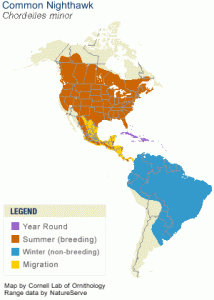This week we start a new series on the blog, a weekly highlighting of birds considered to be at risk in Canada. The Committee on the Status of Endangered Wildlife in Canada (COSEWIC) lists 73 bird species or subspecies, divided into three categories: Endangered, Threatened and Special Concern.
Common Nighthawk (Chordeiles minor) is Threatened in Canada
One of the clearest memories of my childhood is sitting outside on a warm summer evening in northern Alberta, listening to the sound of the rainbirds overhead. This is what my father called the Common Nighthawk, and he always told his budding naturalist daughter that their call meant it was going to rain. Even today, I am tempted to take a quick glance around for rain clouds when I hear their cries overhead.
I was horrified to learn that these marvelous birds are in danger. A visit a few years ago to Grasslands National Park in Saskatchewan produced Common Nighthawks everywhere – on fence posts, on the ground, overhead, and sleeping the day away in a tree above our campsite. I was overjoyed to see their abundance. How is it possible these birds could be on the danger list?
The COSEWIC Status Report says:
The current population size for Common Nighthawks in Canada is estimated at 400,000 breeding adults. Data from the Breeding Bird Survey (BBS), indicates 49.5% decrease in the population in the last ten years.
The main threat to their population in North America is habitat loss and alteration, in particular the reforestation of abandoned agricultural fields and harvested forests, intensive agriculture and the gradual reduction of buildings with flat gravel covered rooftops. Other limiting factors include a general decline in insect populations due to large-scale insecticide use, and climatic fluctuations at breeding sites and during migration.

Range of the Common Nighthawk from AllAboutBirds.org
In contrast to their name, these birds are not hawks. They belong to the Nightjar family. The family is also referred to as ‘goatsuckers’, a name which comes from an ancient erroneous belief that they sucked the milk from goats at night.
Nighthawks are 20-25 cm (8-10”) long with large flat heads, short necks and large eyes. Their mottled plumage of brown, grey, white and black is loose, soft and fluffy, giving them silent flight. The bill is small and weak but very wide so they have a huge gape.
Their tail is notched and the wings are long and pointed with white patches on the primary feathers. Males have a white band on the tail and white patch on the throat patch. Females have less white, no tail band and a brown throat.
Common Nighthawks scoop insects out of the air with the aid of some specialized features. Long bristles along the upper edge of their beak direct prey into the mouth, and when an insect hits the palate, the jaw muscles cause the mouth to snap closed like a mouse trap.
Nighthawks are most active during early morning and late into the evening. During the day, they sleep concealed in trees, perching lengthwise along the branches, not crosswise as other bird species do. Their cryptically coloured plumage helps them blend in with the bark of the trees, and a second look is often required to notice them.
The breeding habitat of the Common Nighthawk is varied and includes open habitats where the ground is devoid of vegetation. Eggs are laid directly on the ground, and incubated by the female only. The nestlings remain in the nest from mid-June to the end of August in Canada and become fully developed at between 45 and 52 days. The life span of the Common Nighthawk is usually 4 to 5 years.



new to new brunswick we just saw at least a hundred night hawks over rogersville. we also noticed a lot of bugs that look white from the ground, and they where obviously feasting on them. beautiful sight.we also noticed them about a week prior just before a storm and at that time thought they where shore birds, but tonight we saw them clearly. aug 17th 2013